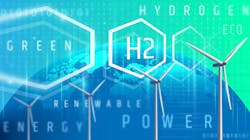Hydrogen vs. BEVs: Reaching energy independence
AUSTIN, Texas—There are battery-electric vehicles, hydrogen fuel-cell vehicles, propane autogas vehicles, and more. With all these options, it’s worth asking which is the closest to powering the trucks of the future and for which applications will they best be suited.
In a recent panel held at the American Trucking Associations Management Conference & Exhibition, representatives from Air Liquide, a large industrial gas company that works in hydrogen; the U.S. Office of Energy and Transportation; and Roland Berger LLC, a global consulting firm, the discussion zeroed in on electric vehicles, hydrogen fuel-cell vehicles, and the infrastructure for both.
See also: Feds fueling $8 billion nationwide hydrogen hub investment
Electric vehicles, both light-duty and medium-duty, have dominated headlines in recent years. However, with the announcement last week that the United States will invest billions of dollars in hydrogen production and infrastructure—along with hydrogen-powered vehicles coming onto the scene in Europe—consumers and businesses may soon find themselves with more alternatively fueled vehicles to add to their fleet.
Hydrogen fuel-cell versus electric vehicles
Hydrogen coming onto the scene is great news for commercial fleets in particular. Hydrogen fuel cell shines as an alternative power source in applications where “a traditional battery just isn’t the best fit,” explained Katie Ellet, president of Air Liquide North America hydrogen energy and mobility.
“If you need a faster fueling time, you have a higher payload, if you [have] a longer haul and don’t have time to sit and charge, hydrogen and fuel cell electric, which is onboard electric generation, gives you that [capability]," Ellet said. "I think for long-haul and heavier-duty applications, that really makes a lot of sense to have the conversion move to fuel cell.”
However, Pepsi has proven battery-electric vehicles to be sufficient for longer and heavier applications, noted Wilfried Aulbur, a senior partner at Roland Berger and responsible for the firm's global commercial vehicles and construction and agriculture business. "They’re running now 82,000-lb. applications with 450 miles, which is a significant achievement,” Aulbur said.
See also: Two fleets weigh in on their EV transition progress
It's important to consider price when comparing the two energy sources, Aulbur continued. Hydrogen prices would need to be “around at least three dollars per kilogram” at the pump, and that’s what he sees as necessary for hydrogen to be “really competitive in an environment where even solid-state batteries are not too far off.”
According to the Department of Energy, hydrogen from renewable energy currently costs $5 per kilogram.
Involving all stakeholders
But competition between the two energy sources probably isn't a good idea, suggested Kevin Miller, a senior adviser for business models at the Joint Office of Energy and Transportation. Instead, the industry should focus on both energy sources and fleet fundamentals to achieve a zero-emissions solution for fleets of all kinds, and this will happen through building an infrastructure to generate the energy sources, transmit those sources, and distribute those sources throughout the industry.
Just as hydrogen development and infrastructure have further to go, so does electrification infrastructure. Miller cited the way utilities price energy usage as an example, which he described as currently “in the weeds.”
See also: EV transition: Fleets 'very worried' about coming decade
To develop infrastructure for either energy source, both Ellet and Aulbur agree it’s going to take effort and collaboration from stakeholders across the industry.
“You have to have the OEMs, the fleets, the utilities, and the regulators come together,” Aulbur said. “A utility cannot invest without knowing there is going to be demand. So, we need to ensure that the demand is there. That means that we have to work with fleets whose operations are actually suitable for deployment.”
For the industry to fully transition to alternative fuel sources, Aulbur said, it will need permitting support to ensure infrastructure is built on a more favorable timeline. As a final point, he said there needs to be a sense of “uniformity” across the country’s 3,000 utilities to facilitate this transition.
The move toward energy independence
Ellet added that although these different energy sources still have further to go in their development, one of the benefits of developing the infrastructure and vehicles for both sources is ultimately energy independence. She said fleets should power their vehicles with whatever resource is abundant where they operate.
We need to “make sure we’re taking advantage of the natural resources in a location,” she emphasized. If those resources are used, Ellet said she believes fleets would have full fuel "security" and "stability," while "taking full advantage of the regional differences."
About the Author
Jade Brasher
Senior Editor Jade Brasher has covered vocational trucking and fleets since 2018. A graduate of The University of Alabama with a degree in journalism, Jade enjoys telling stories about the people behind the wheel and the intricate processes of the ever-evolving trucking industry.


